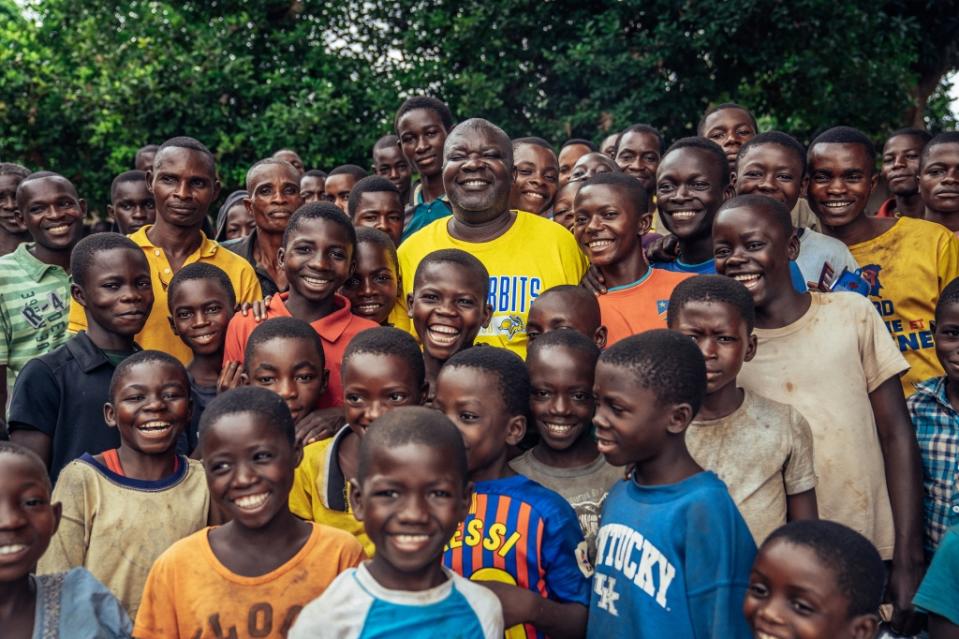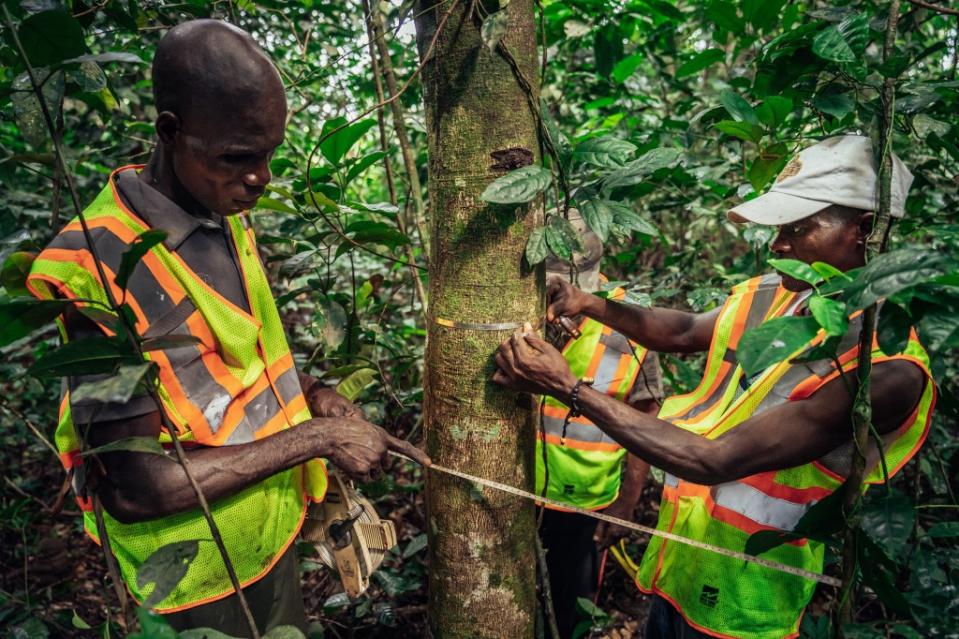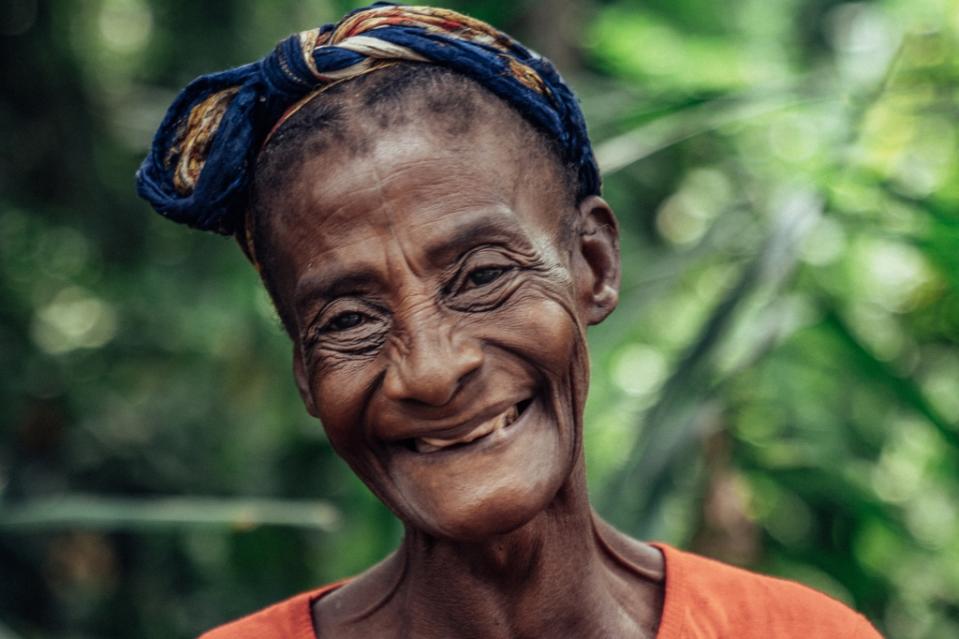The corporate world’s race to net-zero hinges on tiny villages in the DR Congo
The call came while Jean-Robert Bwangoy was on a trip to the United States two years ago. A measles epidemic was tearing through Mai Ndombe—Bwangoy’s hometown in the jungles of the Democratic Republic of the Congo. “More than a hundred children died in one day,” he recalls.
A few hours and several phone calls later, a chartered plane loaded with medicine and supplies including motorbikes, gas, and cash, touched down in the forest. Over the next three weeks, Bwangoy and his team criss-crossed the jungle, transporting provisions and leading health professionals to the villages. Gradually, the epidemic abated.
Bwangoy, 58, is neither a government official nor a charity worker. Rather, he is the DRC country director for Wildlife Works, an American conservation company that promotes a market-based approach meant to transform the fight against climate change in places like Mai Ndombe. The heavily-forested interior of the DRC is often called one of the lungs of the Earth for its ability to absorb the planet's carbon emissions.

Organizations like Wildlife Works have recently taken on even further global importance in light of the deforestation pledges made earlier this month at the COP26 climate meetings—the kind of international pledges, a cynic might point out, that is regularly made with increasing desperation and then broken again and again. The question now is whether an outfit like Wildlife Works can succeed where governments have repeatedly failed to minimize the emission of millions of tons of carbon dioxide (CO2) by saving and growing forests—all financed not by government shame-induced largesse, but by the most market-friendly of tools, the forest carbon-credit.
Forests, front and center
If we're to meet the Paris Agreement goal of limiting the global temperature rise to 1.5C, emissions from deforestation will have to decrease by 70-90% by 2030, research by McKinsey shows. Global Forest Watch has found that pristine, old-growth forests absorb twice the amount of CO2 than previously logged ones with young, regrown trees.
The voluntary carbon markets have become a central tool for channeling capital towards this kind of forest protection. On these markets, the tradable unit is a carbon credit, which is equal to one ton of CO2 kept in the ground or removed from the atmosphere. Entities called “project developers” generate emission-reduction credits through activities ranging from forest conservation to renewable energy, then sell the credits to companies. Project developers use the revenues from the credits they sell to finance their work, while companies use the credits they buy to become carbon neutral.
This process is called offsetting, and not every climate-hawk is a fan. Louise Casson, a climate campaigner at Greenpeace UK, decries the marketplace for credits as a tool corporations could use to avoid eliminating their own fossil-fuel use. “Achieving our climate goals means polluters doing all they can—[and] they can all do a lot more,” she said.
But other advocates like Jeremey Manion, director of forestry carbon markets at the Arbor Day Foundation believe that staving off catastrophe means using offsets alongside other climate strategies, rather than excluding them: “When designed and implemented correctly, verified carbon credit projects are an immediate instrument to fund forest protection.”
A $50 billion market
Corporations that use the offset see it as an immediate and essential tool. “We responded to our employees and customers who wanted us to act right away,” says Amelia DeLuca, managing director for sustainability at Delta Air Lines, which used forest carbon credits to offset emissions, and became the first globally carbon neutral airline in 2020.
“When we included messaging about our carbon neutrality initiatives on the checkout page, there was a conversion lift, demonstrating how being environmentally friendly resonates with consumers,” said Chelsea Mozen, director of impact and sustainability at Etsy, which became carbon neutral in 2019 and was the first global ecommerce platform to offset 100% of carbon emissions from shipping.
The State of the Voluntary Carbon Markets (SOVCM) estimates that the carbon credits market is well on its way to topping $1 billion this year, an all-time record. Furthermore, the carbon credits bought and sold through mid-September represent the equivalent of around 240 million tons of carbon dioxide emissions—tCO2e, for short. These are tiny sums compared to multi-trillion-dollar stock- and commodities markets—or the magnitude of climate change. But given that the total emissions of companies that have made carbon neutral pledges was at 3.5 gigatons as of 2020 (a gigaton is a billion tons), carbon markets seem poised for a blast off.
Indeed there are already indications of this. The SOVCM’s partial 2021 numbers are double that of last year's total in terms of traded value. One of the markets’ benchmarks, the CEC price assessment produced by S&P Global Platts, shows that carbon-credit prices have surged by more than 500% in the first nine months of 2021. McKinsey projects that to meet the Paris Agreement goal, the markets could grow by 15 times, and be worth more than $50 billion by 2030.
Forest carbon credits
Among the various types of credits on the voluntary carbon markets, forest carbon credits, also called REDD+ credits—short for Reducing Emissions from Deforestation or Forest Degradation—are the most richly valued. Carbon market indices by S&P Global Platts show that REDD+ credits were trading in August at twice the value of other types of carbon credits: roughly $12 versus $6.50 on average over the past month.
“The trend is directly related to the social and biodiversity benefits that REDD+ projects deliver; beyond CO2 avoided,” explains Gerald Prolman, CEO of Everland, a conservation marketing company with a large portfolio of REDD+ projects. Such credits have been certified to go beyond climate action and have co-benefits that address other UN Sustainable Development Goals (SDGs) such as no poverty, zero hunger, and decent work and economic growth—attributes highly sought by the markets.
A registry maintained by Verra, the non-profit organization that develops the quality standards against which 70% of projects are certified, shows the mix of companies that retire REDD+ credits—the industry term denoting when carbon credits have been used to offset emissions and therefore represent the most direct link between expenditure and impact—is a diverse one. Some come from high-emissions industries like Chevron and Shell. Others are from luxury sector firms like Gucci and Chanel. Yet others are from food and beverage companies like Ben & Jerry’s and BrewDog, and entertainment industry giants, like Disney and Netflix.
Expenditures are usually confidential, but a few companies see benefits in being transparent. DeLuca says Delta Air Lines spent $30 million and retired 13 million tCO2e of REDD+ credits in 2020. Its REDD+ purchases support projects in Indonesia and Cambodia that together account for almost a million acres of forest, and are home to around 25,000 forest dwellers and endangered species like the Asian elephant and Bornean Orangutan.
And in its 2020 performance update, cosmetics giant Chanel disclosed that it was investing $55 million in nature-based solutions which include REDD+ between 2019 and 2024 in order to achieve carbon neutrality by 2019.
Collectively, companies on Verra’s registry retired around 22 million REDD+ credits in 2020, worth approximately $110 million using reference prices by OPIS. McKinsey estimates that REDD+ could supply emission reductions of up to 2.6 gigatons of carbon dioxide equivalent (GtCO2e) annually—between 4% and 12% of reductions needed from now to 2030 to meet the Paris Agreement goal.
Congo REDD+
Wildlife Works founder Mike Korchinsky is seen as something of a pioneer in the REDD+ space. Even hesitated when Bwangoy invited him to invest in a project in the Congo. The largest country in Central Africa, the DRC contains most of the Congo Forest, the world’s second largest tropical forest and last remaining [IM2] terrestrial carbon sink. The country is also incredibly rich in natural resources, and supplies much of the raw materials that power cellphones and electric vehicles. However, endemic political instability and corruption scare most foreign investors away.
But a visit to Mai Ndombe in 2009 won Korchinsky over. “I saw there was a lot of need, and a lot of capacity, too,” he says.
It took Korchinsky and Bwangoy another two years to secure community consent, and to negotiate with locals and the central government in Kinshasa on how to divvy up the proceeds from the sale of carbon credits—requirements unique to REDD+ projects that ensure benefits flow to those closest to the trees.
After it was agreed that communities would get 25% of all sales, that government taxes of $0.50 per hectare per year or $150,000 annually would be paid regardless of project sales, and that any surplus would be split evenly between the national and local government, and Wildlife Works takes its cut only after project costs were covered. In 2011, the Mai Ndombe REDD+ project was born.
Bigger than the Big Apple
Located in the western central region of the DRC, the project covers an area almost four times the size of New York City and is home to around 180,000 people scattered across 55 dense jungle villages. Employing some 400 local biologists, agronomists, foresters, community organizers, construction engineers, aqua culture experts, and data scientists, the project has three goals: reduce deforestation, increase biodiversity, and empower the community.
To reduce deforestation, 12 of the company’s scientists camp throughout the forest three weeks a month, 11 months a year. They monitor 400 plots of land, each with a 15-meter radius, where they measure and label every tree.
The scientists use “d-tapes” to get the circumference of a tree and laser-based hypsometers to gauge its height, then calculate how much carbon it is storing from the atmosphere based on its biomass. “When we compare plot cards from different years, we can see whether trees have grown, fallen, or new ones have come up,” says head forester Dyems Mbalaka.

To complement the forestry team’s efforts, the agronomy team led by Gauthier Kimpese has introduced sustainable crops such as high-yield cassava and onions, which are Congolese staples that the community grows on marginal land without encroaching on primary forest.
“But by far our best invention is animal enclosures,” Kimpese says.
In the past, villagers planted crops in primary forest an hour’s walk from home, to protect them from village animals. Wildlife Works worked with them to create animal enclosures of a few hectares each, away from the villages. “Now the gardens can be closer to the villagers, and the goats, pigs, and sheep have much more open space to roam and eat; and while they do that, they pasteur and fertilize the land,” Kimpese says.
Hippos and bonobos, too
To boost biodiversity, biologists also patrol the forest floor. The Congo Forest is known for wildlife like elephants, hippos and leopards. It is also the home of bonobos, an endangered species, and our closest genetic cousins found only in the dense jungle south of the Congo River where Mai NDombe is.
“We keep track of wildlife species, and abundance,” says lead biodiversity expert Mathieu Bolaa. They also make note of signs of poaching and dismantle animal traps. The cameras they’ve installed sometimes catch poachers in action. Bruno Ilonga, the project manager and a local community leader then prints out copies and posts them like “Wanted” signs throughout the area. Ilonga uses positive reinforcement, too: “I commiserate with the poachers about how hard their jobs are, then we hire them and retrain them as conservationists.”
“When we started, all the animals had either been eaten or chased away. Since then, the elephant population has gone from zero to around 100, and the bonobo population has doubled. Recently, we’ve even had sightings of pangolins, one of the most trafficked mammals,” Bwangoy adds.
When Wildlife Works asked the communities what benefits they wanted from the project, the overwhelming priority was education. “We want the children to have a better future,” says Basabo Booto, chief of the indigenous Batwa Pygmies in the project area. Before Wildlife Works, the children studied under the trees, recalls Seraphin Mputela, elementary school principal in the village of Nsongo: “If it rained, there was no school. If it rained for 100 days, there was no school for 100 days.”

Wildlife Works has committed to building 28 schools; 10 have been built, and two are underway. “In each village, we hire locals, and use building as a way to teach them new skills, which they can use to earn after the school is finished,” says head engineer Charly Nkuku. Carbon credit revenues also cover teachers’ salaries, school supplies for the 8,500 students in the system, and national exam fees.
Work on the project has avoided the release of some 13 million tCO2e to date. Communities have received their cut of the proceeds, and government taxes have been paid. So far, project costs have exceeded revenue. But this year, for the first time in 10 years, the project expects to be profitable thanks to the growth in corporate demand for carbon credits.
Continued opposition
Despite the benefits REDD+ projects have delivered, they face opposition. “REDD+ has a history full of problems. Scheme after scheme has been unable to prove that it’s led to genuine or permanent reductions in carbon emissions. Companies trying to offset their pollution by putting a price on nature have also harmed land rights for marginalized communities and biodiversity in the Global South,” says Casson of Greenpeace UK.
Specific to Mai Ndombe, a report by Rainforest Foundation UK accuses Wildlife Works of not having properly consulted local communities, and not delivering enough benefits.
“REDD+ is the world’s best—and, frankly, last—hope to withstand the powerful forces that are driving deforestation: big agriculture, big logging, and big mining. It channels finance to communities to preserve their forests, while maintaining local ecosystems and preserving biodiversity. If we don’t preserve our standing forests, it’s game over,” responds Robin Rix, chief policy and markets officer at Verra.
Back in Mai Ndombe, community leader Sakoul Engokulu dismisses the criticism.
“It's like the wind that comes through our villages and brings nothing. Not even in colonial times did we see the schools and clinics we have now. We’ve been forgotten by our government. Logging companies destroyed our forest and scared the animals away with their noisy machines,” he said. “This is the first time anyone has stayed to help us.”
This story was originally featured on Fortune.com
